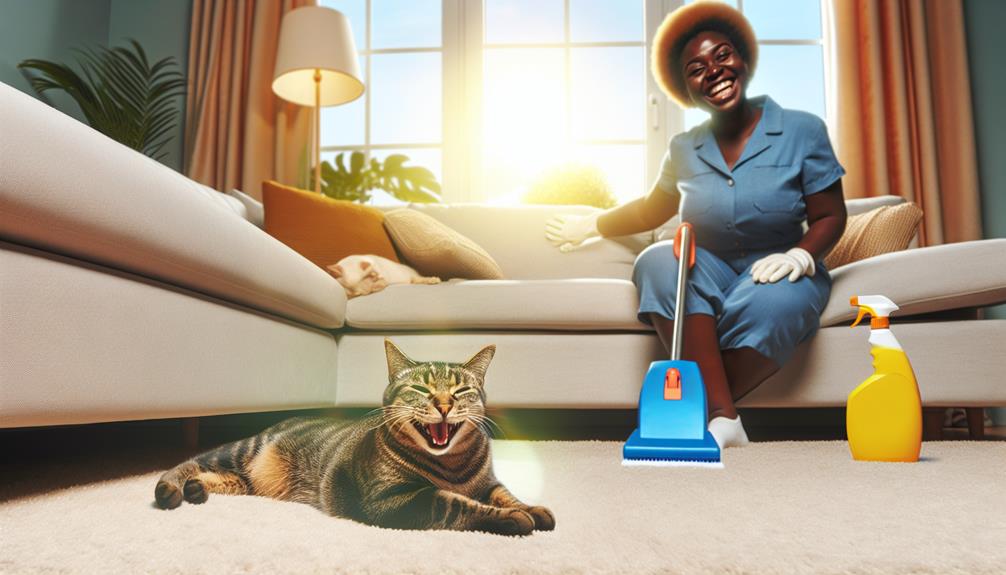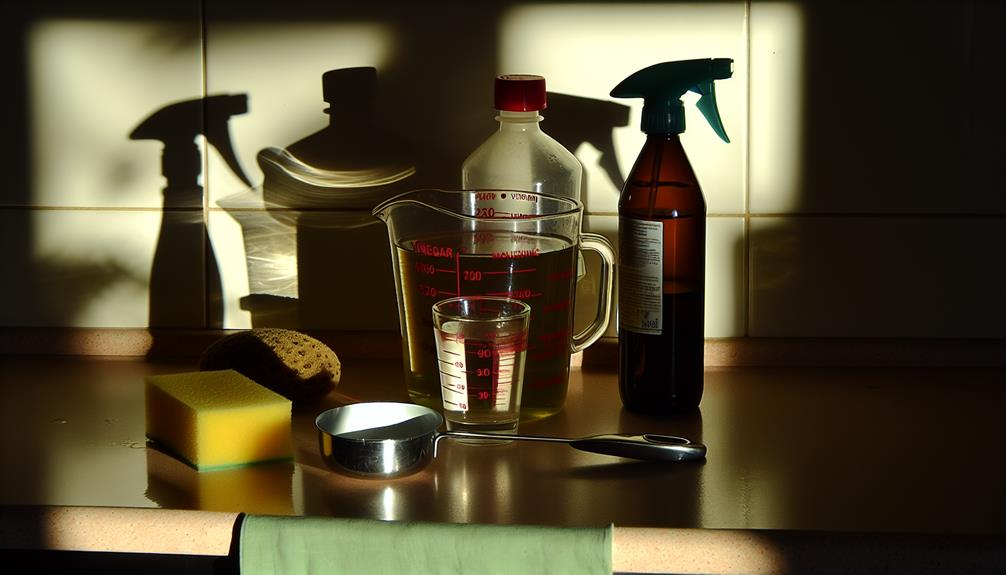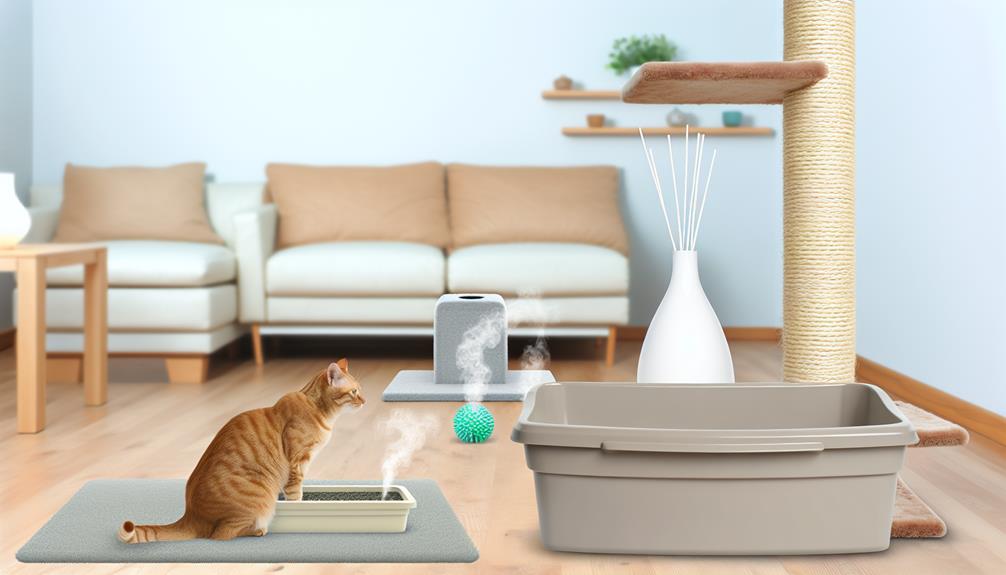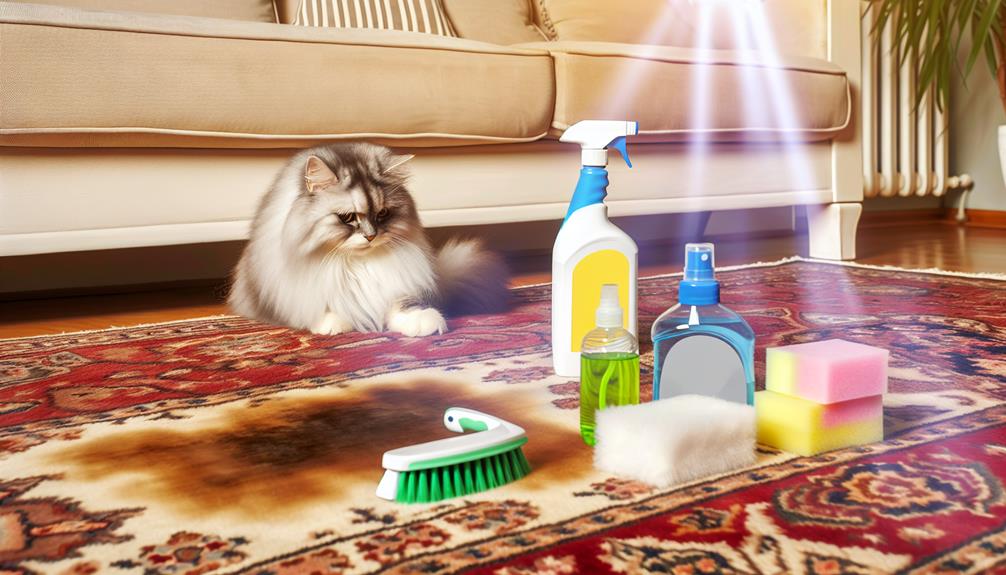Imagine walking into a room and being greeted by the unmistakable, pungent scent of cat pee. It's a problem many pet owners face, but you're not alone, and there are effective ways to tackle it. First, identifying the source is vital, and sometimes hidden stains require a blacklight. Once found, you'll need to blot the area and apply an enzymatic cleaner to break down odor-causing compounds. But that's just the start. What about those stubborn spots where the smell lingers? Let's explore some additional steps to guarantee your home stays fresh and inviting.
Identify the Source
How precisely can you locate the origin of that persistent cat urine odor? Identifying the source is vital for effective odor removal and maintaining ideal pet hygiene. Cats often target specific areas due to various behavioral triggers. Understanding cat behavior is your first step; they might mark territory or express stress. Pinpointing the exact location involves using advanced stain detection techniques such as ultraviolet (UV) light, which makes urine stains fluoresce, revealing hidden spots on different surface types.
Once you've identified the stained area, consider the surface type. Different surfaces—carpet, hardwood, tile, or fabric—require tailored cleaning techniques. For example, enzymatic cleaners are highly effective on organic stains and are designed to break down the urine molecules, making them indispensable in odor removal. These products' effectiveness varies, so selecting a high-quality option is essential.
Incorporate a consistent cleaning frequency into your routine. Regularly inspect and clean potential problem areas to prevent recurring odors. Scent masking agents may provide temporary relief but don't address the underlying issue. Thus, relying solely on them is not recommended for long-term odor control.
Additionally, integrating proper training methods guarantees your cat knows where to urinate. Positive reinforcement and providing multiple litter boxes can mitigate inappropriate urination. If behavioral issues persist, consulting a veterinarian or a pet behaviorist might be necessary.
Blot the Area
When addressing fresh cat urine stains, immediately blotting the area is essential to prevent the liquid from permeating deeper into the material. Effective blotting techniques not only mitigate the spread of urine but also facilitate subsequent cleaning procedures. Use absorbent materials like paper towels or clean cloths to soak up as much liquid as possible.
To maximize efficacy, press the absorbent material firmly onto the stain. Avoid rubbing, as this can drive the urine further into the fabric or carpet fibers. Instead, apply pressure with a blotting motion. The key is to replace saturated towels with dry ones until the area is no longer damp.
Here's a quick reference table to help you understand the ideal blotting techniques:
| Step | Action | Notes |
|---|---|---|
| 1 | Select absorbent material | Use paper towels or clean cloths |
| 2 | Apply pressure | Press firmly, don't rub |
| 3 | Blot repeatedly | Replace towels as needed |
| 4 | Check saturation | Continue until area is dry |
| 5 | Dispose of used materials | Properly discard to avoid odor spread |
Employing these blotting techniques promptly can greatly reduce the extent of the stain and odor. Remember, the faster you act, the less chance the urine has to set into the material. For best outcomes, always have absorbent materials on hand, especially if your cat is prone to accidents.
Use an Enzyme Cleaner

An enzyme cleaner is essential for breaking down the urine proteins that cause persistent odors, ensuring a thorough deodorization. These cleaners prevent re-soiling behavior by eliminating the scent markers that attract cats to the same spot. Additionally, enzyme cleaners are formulated to be safe for home use, making them a practical choice for maintaining a clean environment.
Breaks Down Urine Proteins
Even though cat urine can be notoriously difficult to eliminate, enzyme cleaners offer a scientifically proven solution by breaking down urine proteins at the molecular level. Cat urine composition is complex, consisting of uric acid, urea, creatinine, and various amino acids. These components generate persistent odor molecules that are notoriously hard to neutralize.
Enzyme cleaners work by targeting these urine proteins and breaking them down into harmless compounds. Unlike traditional cleaning agents, which merely mask the smell, enzyme cleaners catalyze a biochemical reaction that disrupts the molecular structure of the odor molecules. This process guarantees that the smell is not just covered up but effectively eradicated.
Here's a breakdown of how enzyme cleaners function:
| Component | Action | Result |
|---|---|---|
| Uric Acid | Enzymes break down uric acid | Neutralizes persistent odor |
| Urea | Converted into ammonia and CO2 | Eliminates scent |
| Creatinine | Decomposed by specific enzymes | Reduces organic waste |
| Amino Acids | Enzymatically degraded | Removes protein residues |
Using an enzyme cleaner, you achieve a clinical level of cleanliness, guaranteeing your home is free from the unpleasant smell of cat urine. The enzymatic action provides a thorough solution, addressing the root cause rather than offering a temporary fix.
Prevents Re-soiling Behavior
Addressing the root cause of re-soiling behavior, enzyme cleaners play a significant role in preventing cats from returning to the same spot to urinate. The science behind enzyme cleaners is meticulous; they break down the urine's molecular compounds, rendering the area scent-free to your cat's sensitive nose. This is essential because residual odors are primary triggers for repeated urination in the same spot, a common cat behavior issue.
By completely eliminating these odor markers, enzyme cleaners disrupt the cycle of re-soiling. This intervention is particularly effective when integrated with proper litter box management. Guarantee the litter box is clean and situated in a quiet, accessible location to encourage its use over inappropriate areas.
From a clinical perspective, understanding cat behavior is important. Cats often re-soil due to stress, medical issues, or territorial marking. Enzyme cleaners are a frontline solution in behavioral modification strategies, addressing both the immediate and underlying causes.
It's critical to apply the cleaner thoroughly, reaching into carpet fibers or porous surfaces where urine may have seeped. Consistent use, combined with behavioral interventions, will dramatically reduce re-soiling incidences, maintaining a hygienic and odor-free environment.
Safe for Home Use
Given the effectiveness of enzyme cleaners in eliminating odor markers, it's also important to verify they are safe for home use. As professionals in the field, we recognize that the safety of your household is paramount. Enzyme cleaners, which function as potent odor neutralizers, break down uric acid crystals, completely removing the source of the smell.
To verify these cleaners are safe for your home environment, consider the following:
- Non-toxic Formulations: Choose enzyme cleaners that are free from harmful chemicals. These natural alternatives are safer for pets, children, and anyone with sensitive systems.
- Biodegradable Ingredients: Opt for products with biodegradable components. This verifies that once the cleaning process is complete, the ingredients safely break down, posing no long-term environmental risks.
- Allergen-Free: Select enzyme cleaners that do not contain common allergens. This minimizes the risk of allergic reactions among household members, verifying a safer indoor atmosphere.
Apply Baking Soda
One effective method for neutralizing cat urine odor involves the application of baking soda, a natural and powerful deodorizer. Baking soda benefits include its ability to absorb and neutralize odors without the use of harsh chemicals, making it safe for both pets and humans. Its crystalline structure allows it to trap odor molecules, effectively reducing the presence of malodorous compounds.
For ideal baking soda application, you should begin by thoroughly blotting the affected area with paper towels or a clean cloth to remove as much urine as possible. This initial step is vital for enhancing the efficacy of the baking soda. Once the area is sufficiently dry, generously sprinkle a layer of baking soda over the urine spot. Guarantee complete coverage, as this will maximize the deodorizing effect.
Allow the baking soda to sit undisturbed on the affected surface for at least 15 minutes. For more persistent odors, extending this duration to overnight may yield superior results. During this period, the baking soda will actively absorb the urine's ammonia and other volatile compounds responsible for the unpleasant smell.
After the designated waiting time, use a vacuum cleaner to remove the baking soda. It's important to use a vacuum with strong suction to guarantee all the baking soda particles are extracted from the carpet fibers or upholstery. Repeat the process if necessary, particularly for older or more saturated stains, to achieve complete odor neutralization.
Try Vinegar Solution

A vinegar solution is another highly effective method for tackling cat urine odor due to its acidic nature, which helps neutralize the alkaline salts in dried urine. Vinegar benefits include its ability to serve as a natural deodorizer, breaking down the molecular structure of uric acid in cat urine and eliminating the odor at its source.
To maximize the efficacy of a vinegar solution, follow these steps:
- Create the Solution: Mix one part white vinegar with one part water in a spray bottle. Using equal parts guarantees the solution is strong enough to counteract the alkaline properties of the urine while remaining safe for most surfaces.
- Application: Saturate the affected area with the vinegar-water solution. Confirm that the solution penetrates deep into the fibers of carpets or upholstery. For hard surfaces, thoroughly wet the area to allow the solution to interact with any residual urine components.
- Dry and Repeat: Allow the vinegar solution to sit for 10-15 minutes. Blot the area with a clean cloth to remove excess moisture. If the odor persists, repeat the application process. Multiple treatments may be necessary for heavily soiled areas.
The acetic acid present in vinegar is a powerful agent for breaking down uric acid crystals, making it an excellent choice for pet owners seeking a natural deodorizer. Remember, though vinegar is effective, its pungent smell may be overwhelming initially. However, this odor dissipates as the solution dries, leaving a fresh environment free of cat urine odor.
Invest in a Blacklight
To effectively identify hidden urine stains, investing in a blacklight is essential. This tool illuminates dried urine, ensuring you can target and treat even the most inconspicuous spots. By locating all affected areas, you can perform a thorough cleaning and eliminate lingering odors.
Locate Hidden Stains
Hidden cat urine stains can be notoriously difficult to detect with the naked eye, but investing in a blacklight can make this task considerably easier. The ultraviolet (UV) light emitted by a blacklight causes phosphors in the urine to fluoresce, thereby enhancing stain detection. This allows you to identify and treat areas that are contributing to persistent odors, which is essential for effective odor neutralization.
When using a blacklight, follow these steps to guarantee accurate stain detection:
- Prepare the Environment: Turn off the lights and close the blinds to create a dark environment. This will maximize the blacklight's effectiveness in revealing hidden stains.
- Systematic Scan: Start from one corner of the room and slowly scan the area. Move the blacklight closely over surfaces, focusing on floors, baseboards, and walls where cats often mark.
- Mark Detected Areas: Once a stain is illuminated, mark it with a sticky note or tape. This will help you remember the exact locations that need treatment, ensuring no hidden stains are missed.
Ensure Thorough Cleaning
When dealing with the persistent issue of cat urine odor, it is vital to guarantee thorough cleaning by investing in a blacklight. A blacklight helps you identify all the urine stains, even the ones that are invisible to the naked eye. This is important because any residual urine can continue to emit odors, making your cleaning efforts futile.
Once you've located the stains using the blacklight, you can effectively target them with appropriate cleaning products and odor neutralizers. Here's a concise guide on how to proceed:
| Step | Action |
|---|---|
| 1 | Darken the room to increase blacklight efficacy. |
| 2 | Scan the area with the blacklight to identify stains. |
| 3 | Mark the stains with a removable tape for easy identification. |
| 4 | Apply enzyme-based cleaning products directly to the stains. |
| 5 | Use odor neutralizers to eliminate any residual smell. |
Enzyme-based cleaning products are particularly effective because they break down the uric acid crystals in cat urine, which are the primary source of the odor. Odor neutralizers, on the other hand, work to eliminate any lingering smells, ensuring a fresher environment. By combining these steps with the use of a blacklight, you can achieve a more thorough and effective cleaning, ultimately eradicating the stubborn cat pee smell.
Prevent Future Accidents

Frequently, preventing future accidents is contingent upon understanding the root causes of your cat's inappropriate urination. Identifying whether the issue stems from medical, psychological, or environmental factors is essential. Once you've pinpointed the cause, you can implement effective deterrent strategies and behavioral training to mitigate the problem.
Firstly, consider the following deterrent strategies to discourage inappropriate urination:
- Environmental Enrichment: Make sure your cat has ample stimulation and a stress-free environment. This includes providing toys, perches, and scratching posts to keep them occupied and reduce anxiety.
- Litter Box Management: Maintain a clean and accessible litter box. Scoop it daily and change the litter regularly. The box should be placed in a quiet, low-traffic area to encourage consistent use.
- Deterrent Products: Utilize products specifically designed to deter cats from urinating in inappropriate areas. These can include sprays or diffusers that release pheromones to promote a sense of calm and security.
Behavioral training is another vital component. It involves reinforcing positive behaviors while discouraging negative ones. Start by observing your cat's routine and rewarding them for using the litter box correctly. This can be done through treats or verbal praise. Additionally, if you catch your cat in the act of urinating outside the litter box, gently redirect them to the appropriate location.
Incorporate these strategies consistently to prevent recurrence. If the problem persists, consulting a veterinarian or a feline behaviorist for further assessment and tailored advice would be wise. They can offer advanced insights and recommend specific interventions based on your cat's unique circumstances, providing a thorough approach to preventing future accidents.
Conclusion
In the battle against the formidable foe that is cat pee odor, your strategic maneuvers—locating the source, blotting, enzymatic warfare, and the mighty baking soda and vinegar artillery—are paramount. Don't forget your trusty blacklight for hidden ambushes. By maintaining a clean litter box and enriching your cat's environment, you'll transform your home into an impregnable fortress of freshness. With these expert tactics, you'll obliterate any trace of cat pee smell, restoring your domain to its pristine glory.
